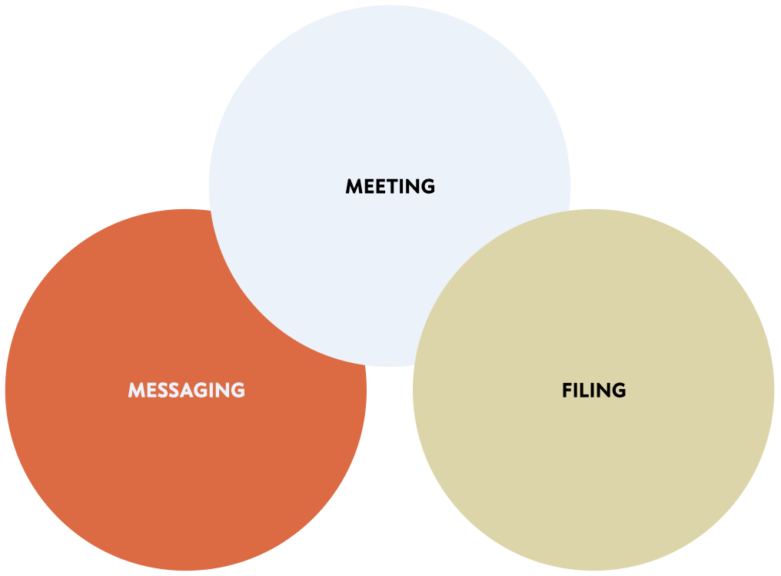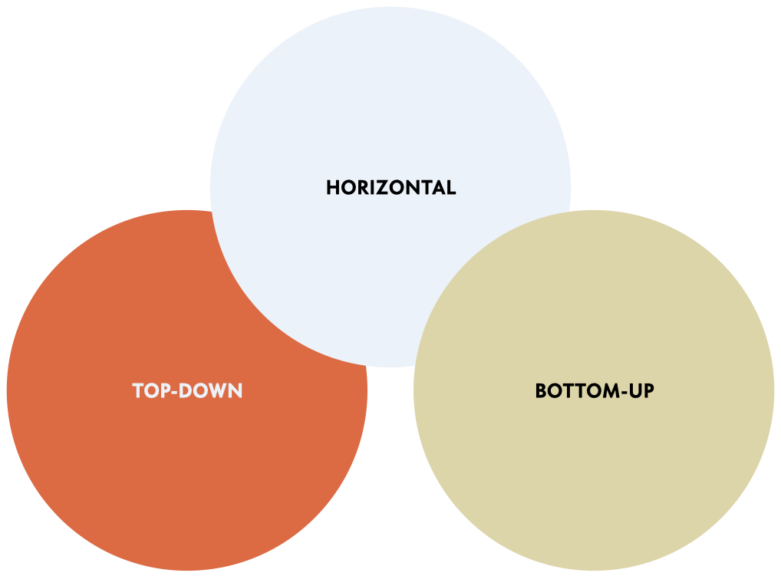The intranet is the unsung hero amongst PR channels.
In digital PR, where flashy social media platforms and sophisticated external communication tools often steal the spotlight, the humble intranet remains an essential organisational platform.
In other words: The intranet is the organisation’s central nervous system.
Here we go:
The 3‑by‑3 Intranet Model

Spin Academy | Online PR Courses
The 3‑by‑3 Intranet Model
The 3 Intranet Pillars
When evaluating or setting up an intranet, it’s crucial to focus on its core functionalities:
This triad forms the backbone of any effective intranet, catering to the most fundamental needs of an organization. Each of these components plays a vital role in the functionality and effectiveness of an intranet. When well-executed, they work together seamlessly to support the organisation’s communication, collaboration, and information management needs.

The 3 Intranet Dimensions
In the context of an intranet, communication typically occurs in three primary dimensions: top-down, bottom-up, and horizontal.
By effectively leveraging these three dimensions of communication, an intranet can become a powerful tool for enhancing transparency, collaboration, and overall organisational efficiency. Each dimension complements the others, creating a comprehensive communication ecosystem that benefits the entire organisation.
Learn more: The Intranet: The Unsung Hero Amongst PR Channels
💡 Subscribe and get a free ebook on how to get better PR ideas.
Why the Intranet Matters
The intranet extends far beyond just a repository of documents or a corporate bulletin board. Intranets are often essential in fostering organisational learning, enhancing social networking, and facilitating seamless internal communication.
“Intranets as knowledge management tools within organizations can enhance organizational learning by fostering social networking and facilitating communication among employees.”
Source: Encyclopedia of Knowledge Management 1Boersma, F., & Kingma, S. (2011). Organizational Learning Facilitation with Intranet (2.0): A Socio-Cultural Approach. Encyclopedia of Knowledge Management, … Continue reading
A well-structured intranet can streamline processes, encourage collaboration, and promote a shared sense of purpose. It acts as the central nervous system of an organization, efficiently connecting various parts to function as a cohesive whole.
The intranet is an indispensable tool in the internal digital arsenal of organizations. Its potential to facilitate communication, streamline processes, and foster a collaborative environment is immense. As we navigate the complexities of the digital workplace, let’s not overlook the intranet — the unsung hero that keeps our organizations connected and functioning effectively.
The 3 Pillars of an Intranet
Pillar 1: Messaging
Messaging is the core communication function of an intranet, encompassing all forms of digital messaging, including emails, instant messaging, and chat rooms. It’s the primary tool for day-to-day communication within the organisation.
The messaging function ensures quick, effective, and efficient communication among employees. It allows for immediate information sharing and feedback, ensuring everyone stays connected and informed.
Messaging can be implemented through integrated email systems, chat applications, and instant messaging tools. These platforms should support one-on-one conversations, group discussions, and broadcast messages. Ideally, they should be easily accessible, secure, and capable of handling various media types (text, images, videos).
Pillar 2: Meetings
The intranet’s meeting functionality involves scheduling, managing, and facilitating meetings within the organisation. It includes calendar management, video conferencing tools, and resources for virtual collaboration.
The meetings component is designed to streamline the process of organising and conducting meetings, thereby improving collaboration and decision-making. It ensures that meetings are productive and that relevant resources are readily accessible.
Effective implementation includes integrated calendars for scheduling, features for sending meeting invites and reminders, and tools for virtual meetings such as video conferencing. It may also provide access to shared documents and collaborative workspaces where meeting agendas, minutes, and follow-up actions can be stored and accessed.
Pillar 3: Filing
Filing refers to storing, organising, and retrieving documents and other digital assets on the intranet. This includes document management systems, digital libraries, and databases.
The filing system is essential for managing an organisation’s vast amount of information. It enables employees to efficiently store, locate, and collaborate on documents, ensuring that important information is secure yet accessible when needed.
A well-organised filing system on an intranet includes features for document upload and download, version control, access permissions, and search functionality. It should support various file formats and provide a logical, user-friendly structure for organising documents into folders and categories.
The 3 Dimensions of an Intranet
Dimension 1: Top-Down Communication
This dimension refers to the flow of information from the higher levels of the organisation’s hierarchy to the lower levels. It typically includes official announcements, policy changes, organisational updates, and strategic directions.
The main aim is to inform all employees about the company’s goals, achievements, and changes. It ensures that everyone is aligned with the organisation’s vision and objectives.
On an intranet, top-down communication is facilitated through official news channels, broadcast emails, leadership blogs, and dedicated sections for corporate announcements. It’s important that this content is easily accessible and prominently displayed.
Dimension 2: Bottom-Up Communication
This is the upward flow of information from lower-level employees to the management and leadership teams. It encompasses feedback, suggestions, concerns, and insights from the staff.
Bottom-up communication is crucial for fostering a sense of inclusion and empowerment among employees. It allows the management to gather ground-level insights and address issues that may not be visible at the top.
Tools such as surveys, feedback forms, and forums on the intranet enable bottom-up communication. Encouraging employees to share their ideas and feedback through these channels can lead to a more engaged and productive workforce.
Dimension 3: Horizontal Communication
This type of communication occurs among employees at the same level within the organisational hierarchy. It involves exchanging information, collaborating, and sharing knowledge among peers.
Horizontal communication is key to breaking down silos, fostering teamwork, and encouraging cross-departmental collaboration. It facilitates knowledge-sharing and problem-solving among employees who may not interact frequently in their regular work routines.
The intranet can support horizontal communication through social networking features, team collaboration spaces, shared document libraries, and internal chat systems. These tools help create a more connected and collaborative work environment.
Intranet Best Practices
Here are 10 best practice tips on how to maximize the effectiveness of your intranet for corporate and/or internal communications:
Implementing these best practices can significantly enhance the intranet’s role in internal communications, turning it into a dynamic, engaging, and indispensable resource within your organization.
Beware the Law of Diminishing Returns
While it’s tempting to keep adding features to an intranet, it’s crucial to be wary of the law of diminishing returns. The benefits of a more complex system must be weighed against the additional costs and potential for decreased user-friendliness. The synergy promised by integrating various components into a single system is often exaggerated compared to the additional cost and complexity involved.

Thanks for reading. Please consider sharing my public relations blog with other communication and marketing professionals. If you have questions (or want to retain my PR services), please contact me at jerry@spinfactory.com.
PR Resource: Pavlov’s Inbox
Spin Academy | Online PR Courses
Pavlov’s Inbox
Most email productivity systems (e.g. Inbox Zero and similar systems) focus on structure and efficiency. Such systems run the risk of rewarding unfavourable sender behaviours.
Pavlov’s Inbox is a system built around the psychological idea that your inbox problems aren’t email problems — they’re sender problems.
Pavlov’s Inbox assumes that you can influence the behaviours of those sending you emails — via conditioning.
The typical result of Pavel’s Inbox is that you quickly get more and more good emails from favourable senders and fewer and fewer bad emails from unfavourable senders.
How To Reward Favourable Senders
How To Punish Unfavourable Senders
Please note that the punishing aspect should be executed in a socially viable manner (since being confrontational or aggressive as “punishment” is likely detrimental to your professional reputation).
Learn more: Pavlov’s Inbox
💡 Subscribe and get a free ebook on how to get better PR ideas.
ANNOTATIONS
| 1 | Boersma, F., & Kingma, S. (2011). Organizational Learning Facilitation with Intranet (2.0): A Socio-Cultural Approach. Encyclopedia of Knowledge Management, 1280 – 1289. https://doi.org/10.4018/978 – 1‑59904 – 931‑1.CH122 |
|---|
























